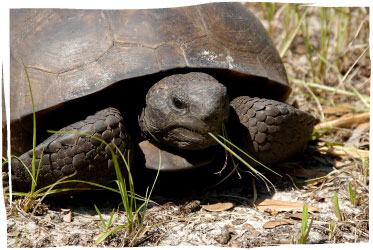Wildlife

The Gopher Tortoise is one of 22 state or federally protected species that calls the Peace River Basin its home. Re-location projects heralded as successes by the phosphate industry only serve to transmit disease from one tortoise population to another.
Strip mining alters ecosystems forever, including plant and animal life. Mining companies are required to reclaim the land, filling in the mining pits and planting new vegetation. While some effort is better than none, many environmentalists and scientists don't believe the process has worked well in the past. This is reflected in the results of the FDEP Cumulative Impact Study. When reclamation fails, or when replanting takes years, wildlife populations move or die, unable to survive in a depleted environment.
The Burrowing Owl makes its nest in open fields. The encroachment of phosphate strip mining (seen in the background)will displace the owl and other wildlife if the strip mining is allowed.
All animals need water, and most, from tortoises to birds, require specific habitat to survive. A healthy ecosystem supports diverse and abundant plant and animal communities. And, reclamation programs sometimes require the relocation of entire plant or animal communities, but this is rarely a good solution. Years ago, scientists believed that the way to save gopher tortoises was to move them to new habitat. But we learned that when different gopher tortoise populations are mixed, they could spread disease, endangering both populations. And how, exactly, does one go about moving sandhill cranes, panthers, burrowing owls or other protected species? And what does an eastern indigo snake relocation program look like?
A Great Horned Owl protecting his prey. Owls are important predators key to controlling the rodent population. Strip mining destroys their habitat. This affects the populations of wildlife.
University of South Florida scientists have discovered that reclaimed habitat doesn't support wildlife populations as was once thought. Reclaimed areas are isolated from other communities making migration and other natural behaviors difficult*.
We know that fish, birds and other wildlife depend on sufficient and diverse habitat. When that habitat is gone, so are the populations of wildlife that depended on them. No matter how good we get, we cannot really replace that which is constructed by nature.
*McCoy ED, Mushinsky HR (2002) MEASURING THE SUCCESS OF WILDLIFE COMMUNITY RESTORATION. Ecological Applications: Vol. 12, No. 6 pp. 1861-1871